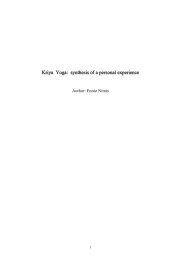A Critique of The German Ideology
A Critique of The German Ideology
A Critique of The German Ideology
Create successful ePaper yourself
Turn your PDF publications into a flip-book with our unique Google optimized e-Paper software.
manufactures were at first confined to the home market. Besides the premises already<br />
mentioned manufactures depend on an already advanced concentration <strong>of</strong> population,<br />
particularly in the countryside, and <strong>of</strong> capital, which began to accumulate in the hands <strong>of</strong><br />
individuals, partly in the guilds in spite <strong>of</strong> the guild regulations, partly among the<br />
merchants.<br />
That labour which from the first presupposed a machine, even <strong>of</strong> the crudest sort, soon<br />
showed itself the most capable <strong>of</strong> development. Weaving, earlier carried on in the<br />
country by the peasants as a secondary occupation to procure their clothing, was the first<br />
labour to receive an impetus and a further development through the extension <strong>of</strong><br />
commerce. Weaving was the first and remained the principal manufacture. <strong>The</strong> rising<br />
demand for clothing materials, consequent on the growth <strong>of</strong> population, the growing<br />
accumulation and mobilisation <strong>of</strong> natural capital through accelerated circulation, the<br />
demand for luxuries called forth by the latter and favoured generally by the gradual<br />
extension <strong>of</strong> commerce, gave weaving a quantitative and qualitative stimulus, which<br />
wrenched it out <strong>of</strong> the form <strong>of</strong> production hitherto existing. Alongside the peasants<br />
weaving for their own use, who continued, and still continue, with this sort <strong>of</strong> work, there<br />
emerged a new class <strong>of</strong> weavers in the towns, whose fabrics were destined for the whole<br />
home market and usually for foreign markets too.<br />
Weaving, an occupation demanding in most cases little skill and soon splitting up into<br />
countless branches, by its whole nature resisted the trammels <strong>of</strong> the guild. Weaving was,<br />
therefore, carried on mostly in villages and market-centres without guild organisation,<br />
which gradually became towns, and indeed the most flourishing towns in each land.<br />
With guild-free manufacture, property relations also quickly changed. <strong>The</strong> first advance<br />
beyond naturally derived estate capital was provided by the rise <strong>of</strong> merchants whose<br />
capital was from the beginning movable, capital in the modern sense as far as one can<br />
speak <strong>of</strong> it, given the circumstances <strong>of</strong> those times. <strong>The</strong> second advance came with<br />
manufacture, which again made mobile a mass <strong>of</strong> natural capital, and altogether increased<br />
the mass <strong>of</strong> movable capital as against that <strong>of</strong> natural capital.<br />
At the same time, manufacture became a refuge <strong>of</strong> the peasants from the guilds which<br />
excluded them or paid them badly, just as earlier the guild-towns had [served] as a refuge<br />
for the peasants from [the oppressive landed nobility].<br />
Simultaneously with the beginning <strong>of</strong> manufactures there was a period <strong>of</strong> vagabondage<br />
caused by the abolition <strong>of</strong> the feudal bodies <strong>of</strong> retainers, the disbanding <strong>of</strong> the swollen<br />
armies which had flocked to serve the kings against their vassals, the improvement <strong>of</strong><br />
agriculture, and the transformation <strong>of</strong> great strips <strong>of</strong> tillage into pasture land. From this<br />
alone it is clear how this vagabondage is strictly connected with the disintegration <strong>of</strong> the<br />
feudal system. As early as the thirteenth century we find isolated epochs <strong>of</strong> this kind, but<br />
only at the end <strong>of</strong> the fifteenth and beginning <strong>of</strong> the sixteenth does this vagabondage<br />
make a general and permanent appearance. <strong>The</strong>se vagabonds, who were so numerous

















